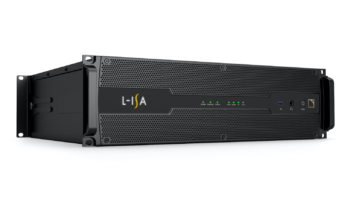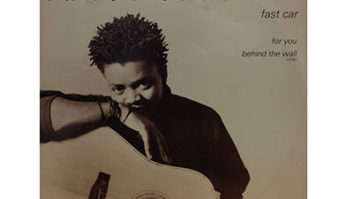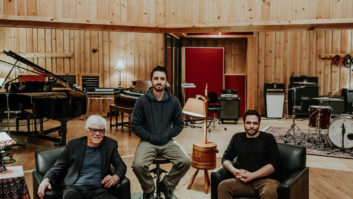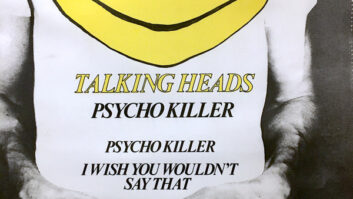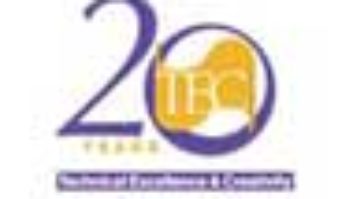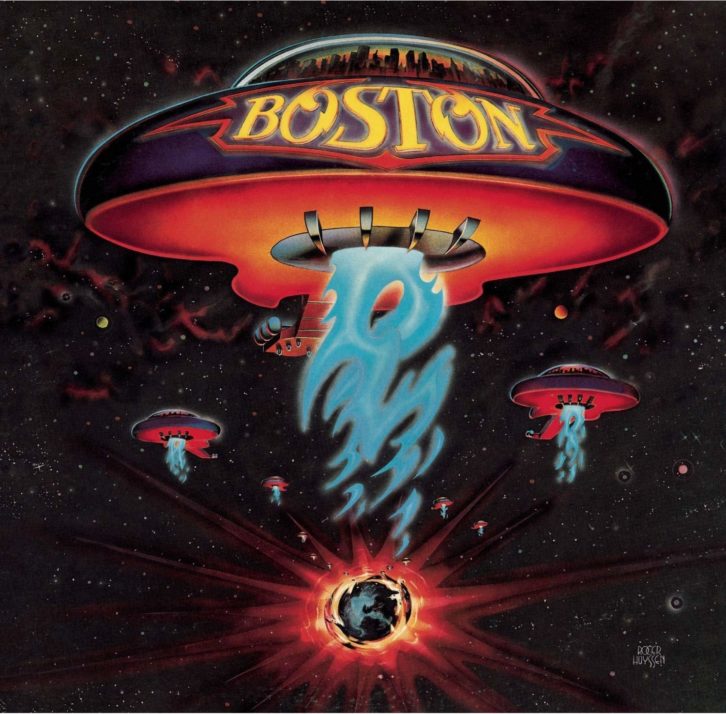
In 1976, mainstream American rock was making the transition from blues-based proto-metal to what would become a decade-and-a-half’s worth of power pop. It was an era when the recording of the pistons of rock – guitars and drums – made the transition from a crude craft to a true science, as guitar sounds began to receive the kind of data processing heretofore reserved for NASA telemetry.
“More Than A Feeling,” the first single from Boston’s eponymous debut album, hit the airwaves that autumn (making it to Number 5), and acted as a pivot in this transition, combining some of the ebullience of the rock era’s early days with the precision and technology that would mark rock record productions from then on. That song and album also set benchmarks for the record business. Boston became the best-selling pop debut effort in history, a title it held for a decade before it was supplanted by Whitney Houston’s first album. It ultimately sold 16 million copies in the process of creating a reference point for production values and studio technology that would stand for years.
Not surprisingly, the group’s main muse – guitarist and songwriter Tom Scholz – was an interesting blend of Brian Wilson and Albert Einstein. The M.I.T. graduate was working for Polaroid when he hooked up with vocalist Brad Delp and his local rock band. Though Scholz signed on as a keyboardist, he also began learning guitar, and his quick mastery of the instrument soon allowed him to take full control of the band. Scholz’s innate technical wizardry allowed him to build one of the first project studios, a 12-track Scully recorder/Dan Flickinger console affair where the band recorded demos that led to their signing by Epic in 1975 and which served as the basis of much of the first album’s tracks.
When producer John Boylan was brought into the picture, “More Than a Feeling” and most of the songs on the debut record were just about completed. Boylan, who had previously produced records for Linda Ronstadt, Brewer & Shipley, Pure Prairie League and Roger McGuinn, was contacted by old friend Paul Ahern, who along with local promotion manager Charlie McKenzie, had recently formed a company to manage Boston and were in search of a deal. “The band had been turned down by several labels already, including Epic,” Boylan recalls. “Up to that point, Tom [Scholz] had been sending tapes to record companies over the transom, sending them in cold. He needed someone who knew the business and was conversely known by it. Paul was an old friend I’d met through my connection with Linda, and I liked Charlie’s flamboyant style of promotion – he would send telegrams to radio stations asking them to play his songs.”
Boylan came to Boston and listened to Scholz’s 12-track tapes. “I loved it and wanted to work with it,” he says. “I knew what was wrong with the recordings immediately: Tom was an obvious genius, but he didn’t know how to record acoustic instruments. The drums and acoustic guitars were amateurish, but the guitars sounded amazing.”
Scholz’s Scully 12-track had a linear-restoration circuit built in, which could restore the uppermost transient lost in the analog circuitry. It seemed to Boylan that some of the sharpness of Scholz’s genius came from his own conflict with analog and digital audio technology. “Tom knew what digital technology was capable of,” Boylan recalls. “The first Eventide sampler was out then, though it had a terrible sampling rate. But Tom would then invent analog devices to do what the digital boxes were trying to do. His first doubler was actually an analog bucket-brigade device.”
Bringing Boylan to the project, along with management, completed the team that Boston needed to get a major-label deal, and the band signed with Epic, though not before the label, responding to rumors that the “band” was actually a mad genius at work in a basement, asked to see them perform. “They needed to see some bodies on a stage, and they quickly added a live drummer [Sib Hashian] and bassist [Fran Sheehan] to the core of Scholz, vocalist Brad Delp and Goudreau.
When Boylan arrived in Boston in early 1976, he found Scholz still working at Polaroid, deeply involved in a pet project for company founder Edward Land, developing an instant-movie camera, a project Scholz confided to Boylan that he felt would never work, and despite the millions of dollars that and threw at it, it was quickly decimated by the arrival of the VCR. But the fact that Scholz would stay on at Polaroid, even as he and the band were on the verge of the big record deal, underscored to Boylan Scholz’s own insecurities – about money and his way of working. “Tom didn’t want an outside producer; he wanted to do this all himself,” Boylan says matter-of-factly. “He accepted me because he knew it was politically necessary. I looked at the situation and told Charlie and Paul in a meeting that this project will sound better if Tom gets to do it the way he wants. What I could do to help it is to make his acoustic sound better, and to run interference with the label while he works out of his basement.”
Boylan recognized Scholz’s talent, and had already formulated in his mind that once he had gotten Scholz on the right track with drums – achieved by flying in engineer Paul Grupp from Los Angeles to instruct Scholz in microphone technique (“Tom proved to be a very fast study,” Boylan says admiringly) – his own hands-on involvement would center on recording the vocals and mixing. Scholz was relieved and agreed readily to that arrangement, Boylan recalls. But before he could get to that stage, Boylan had to orchestrate one of the most complex corporate capers in the history of the music business.
“I had gotten a budget from Epic [he estimates the amount spent in the end was just $28,000], but the more important question from Epic’s admin. department was,`Where are you guys going to record?'” Boylan explains. This was a loaded question. Several years before, Epic, which is part of the Columbia Records corporate family, had signed a disadvantageous agreement with NABET, the union representing electrical and broadcast engineers. The agreement had a “featherbedding” clause that, according to Boylan, “would have made Karl Marx grin from ear to ear.” Any recording done outside of a Columbia-owned studio [the company’s facilities were in New York, Los Angeles and Nashville at the time] but within a 250-mile radius of one of those studios required that a paid union engineer be present, even if all he did was file his nails. Boston, where the band called home and wanted to work, is 211 miles from New York City.
Boylan’s first imperative as producer was to put up a smokescreen, because the notion of a stiff union engineer sitting next to the compulsively controlling (and still Polaroid-employed) Scholz in the basement of his house on School Street in the lower-middle-class Boston suburb of Watertown was, alternately, too horrible and too comic to contemplate. “Can you picture it?” Boylan asks. “There’s Tom working in his basement after working all day at Polaroid, sitting there recording his guitars through a Marshall and the prototype of his Power Soak, which at the time used a massive resistor taken from a theatrical lighting system and that was the size of a briefcase, while some guy from the union was waiting for him?”
So Boylan developed an elaborate ruse that involved flying the rest of the band to Los Angeles, where they were working on non-Scholz material, such as “Let Me Take You Home Tonight,” while Scholz remained in his basement, safe from Epic’s accountants. Boylan says he paid for the equipment rentals for Scholz himself to avoid tipping off Epic’s auditors.
That spring, Boylan returned to Boston to hear the tracks, on which Scholz had recut drums and other percussion and keyboard parts. Boylan then hired a remote truck in Providence, RI, and had it come to Watertown, where it ran a snake through the basement window of Scholz’s home to transfer his tracks to a 3M-79 2-inch 24-track deck, going from 15 ips on the one-inch 112-track tape to 30 ips on the 3M multitrack. The tapes were taken to Los Angeles, where Boylan, Scholz and Delp settled in for vocals.
“Brad was one of the easiest singers to work with that I’ve ever met,” says Boylan. “He actually hits those high notes; there’s nothing electronic helping him. And he did it fast.” Singing into a Neumann solid-state 87, running through a Quad Eight console using the onboard mic-pre and EQ and an outboard Quad Eight limiter, Delp sang “More Than A Feeling” in Capitol’s Studio C with Warren Dewey engineering the overdubs. One of the more remarkable vocal pyrotechnics on an album where Delp’s singing gives Scholz’s guitar work a run for its money is on the passage where Delp’s ever-rising tenor rides into the first notes of the signature guitar solo, a move Boylan says was planned and executed flawlessly on virtually the first take. All vocals were double-tracked except the lead vocal, and all the parts were done by Delp in quick succession.
The rest of the band was less involved. “If Tom could have played drums, he would have; he was that compulsive about the control of the project,” Boylan observes. “He was particularly so with Barry, who had taught him to play the guitar in the first place. But with Brad, Tom seemed to find his limit. He knew he couldn’t sing like that. He just sat there and listened for pitch and tempo.”
It was in the mixing of the song that Boylan found his only real confrontation with the autocratic Scholz. At Westlake Studios’ now-gone 6311 Wilshire Blvd. location, in a three-position manual mix – unautomated since all the tracks were filled, leaving no room for the two tracks required by the studio’s new and rudimentary API console automation system – Scholz handled the guitar tracks, Boylan the drums and Dewey rode the vocals, with Steve Hodge assisting. “It was a tug-of-war in the beginning,” says Boylan. “I want to make sure any Joe Blow can hear the vocals, and Tom is pushing the guitars up in the mix unceasingly. I was also trying to get the backbeat back into the track; I put a gate on the snare to get the hi-hat out of there and give the snare more punch. Meanwhile, Tom loves nothing more than the crash of cymbals and loud guitars.”
Boylan concedes that “More Than a Feeling” is a heavily compressed recording, but notes that its squash came not electronically but rather from what he calls “manual compression.” “We were pushing everything on the board to the edge,” he says. “The interesting thing is that Tom had decided he wanted it to fade in with the acoustic guitars, and that kind of fools radio station compressors into thinking it’s a quiet song, so they don’t latch on to it right away.”
But aside from nifty, if unplanned tricks like that, Boylan says he also learned something more lasting from this mixing session. “And it’s something which I put to good use to this day,” he notes. “People, as they listen to a record, will always be able to find the vocals when they want to. I learned that the lead vocal is more apparent than you think it is when you’re in the middle of a mix.”
Boylan also honed his psychological skills working with Scholz. “He’s a genius and he’s autocratic – when it comes to opinions, with him it’s either`my way or the highway,'” he says without judgment. “When you run into a situation where there is a difference of opinion, I had to remind myself that my purpose in this project was to give Tom the room to do what his vision demanded, but to keep him from shooting himself in the foot. So you use karate: you figure out which way he’s going and you go in the same direction, all the while quietly, but seriously, manipulating the situation to move it where you want to go in the end. You never confront. You nudge. That’s part of producing records.”
That first Boston album would be only part of Scholz’s legacy. In 1981, he formed Scholz Research & Design, Inc., a company founded to create high-tech music equipment. After first developing the Power Soak for DI recording, SR&D introduced the Rockman, a small, inexpensive guitar amplifier with headphones which, along with the Tascam PortaStudio, helped launch the project studio as a mass-market concept.
The Rockman, and later variants such as the Bass Rockman, would eventually make Scholz as wealthy from his business and technology pursuits as from his music. He would need it. He spent much of the 1980s in litigation with former bandmates – for instance, Boston guitarist Barry Goudreau sued him, asserting that he hindered Goudreau’s professional career by taking so long to make follow-up recordings. Scholz’s legendary pursuit of perfection – he is rumored to have re-recorded the drum tracks to one song 108 times – also put him at legal loggerheads with Epic, which also sued him. Boston’s second album, Don’t Look Back, took two years to make; the band’s third and final LP, Third Stage, was not released until 1986, a decade after “More Than a Feeling” stormed the airwaves and on a different label, MCA.
